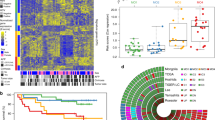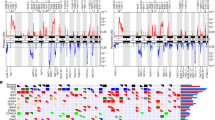Abstract
Hepatocellular carcinoma (HCC) is the third leading cause of cancer-related death worldwide. We sequenced and analyzed the whole genomes of 27 HCCs, 25 of which were associated with hepatitis B or C virus infections, including two sets of multicentric tumors. Although no common somatic mutations were identified in the multicentric tumor pairs, their whole-genome substitution patterns were similar, suggesting that these tumors developed from independent mutations, although their shared etiological backgrounds may have strongly influenced their somatic mutation patterns. Statistical and functional analyses yielded a list of recurrently mutated genes. Multiple chromatin regulators, including ARID1A, ARID1B, ARID2, MLL and MLL3, were mutated in ∼50% of the tumors. Hepatitis B virus genome integration in the TERT locus was frequently observed in a high clonal proportion. Our whole-genome sequencing analysis of HCCs identified the influence of etiological background on somatic mutation patterns and subsequent carcinogenesis, as well as recurrent mutations in chromatin regulators in HCCs.
This is a preview of subscription content, access via your institution
Access options
Subscribe to this journal
Receive 12 print issues and online access
$209.00 per year
only $17.42 per issue
Buy this article
- Purchase on Springer Link
- Instant access to full article PDF
Prices may be subject to local taxes which are calculated during checkout





Similar content being viewed by others
Accession codes
Primary accessions
Gene Expression Omnibus
Referenced accessions
NCBI Reference Sequence
References
Totoki, Y. et al. High-resolution characterization of a hepatocellular carcinoma genome. Nat. Genet. 43, 464–469 (2011).
Greenman, C. et al. Patterns of somatic mutation in human cancer genomes. Nature 446, 153–158 (2007).
El-Serag, H.B. & Rudolph, K.L. Hepatocellular carcinoma: epidemiology and molecular carcinogenesis. Gastroenterology 132, 2557–2576 (2007).
Laurent-Puig, P. & Zucman-Rossi, J. Genetics of hepatocellular tumors. Oncogene 25, 3778–3786 (2006).
Wiegand, K.C. et al. ARID1A mutations in endometriosis-associated ovarian carcinomas. N. Engl. J. Med. 363, 1532–1543 (2010).
Jones, S. et al. Somatic mutations in the chromatin remodeling gene ARID1A occur in several tumor types. Hum. Mutat. 33, 100–103 (2012).
Ferby, I. et al. Mig6 is a negative regulator of EGF receptor–mediated skin morphogenesis and tumor formation. Nat. Med. 12, 568–573 (2006).
Reschke, M. et al. Mitogen-inducible gene–6 is a negative regulator of epidermal growth factor receptor signaling in hepatocytes and human hepatocellular carcinoma. Hepatology 51, 1383–1390 (2010).
Li, Y., Zhou, Z., Alimandi, M. & Chen, C. WW domain containing E3 ubiquitin protein ligase 1 targets the full-length ErbB4 for ubiquitin-mediated degradation in breast cancer. Oncogene 28, 2948–2958 (2009).
Shah, S.P. et al. The clonal and mutational evolution spectrum of primary triple-negative breast cancers. Nature published online doi:10.1038/nature10933 (4 April 2012).
Huang, W., Sherman, B.T. & Lempicki, R.A. Bioinformatics enrichment tools: paths toward the comprehensive functional analysis of large gene lists. Nucleic Acids Res. 37, 1–13 (2009).
Parsons, D.W. et al. The genetic landscape of the childhood cancer medulloblastoma. Science 331, 435–439 (2011).
Varela, I. et al. Exome sequencing identifies frequent mutation of the SWI/SNF complex gene PBRM1 in renal carcinoma. Nature 469, 539–542 (2011).
Lee, J. et al. A tumor suppressive coactivator complex of p53 containing ASC-2 and histone H3-lysine-4 methyltransferase MLL3 or its paralogue MLL4. Proc. Natl. Acad. Sci. USA 106, 8513–8518 (2009).
Khalil, A.M. et al. Many human large intergenic noncoding RNAs associate with chromatin-modifying complexes and affect gene expression. Proc. Natl. Acad. Sci. USA 106, 11667–11672 (2009).
Jiang, Z. et al. The effects of hepatitis B virus integration into the genomes of hepatocellular carcinoma patients. Genome Res. 22, 593–601 (2012).
Paterlini-Bréchot, P. et al. Hepatitis B virus–related insertional mutagenesis occurs frequently in human liver cancers and recurrently targets human telomerase gene. Oncogene 22, 3911–3916 (2003).
Shafritz, D.A., Shouval, D., Sherman, H.I., Hadziyannis, S.J. & Kew, M.C. Integration of hepatitis B virus DNA into the genome of liver cells in chronic liver disease and hepatocellular carcinoma. Studies in percutaneous liver biopsies and post-mortem tissue specimens. N. Engl. J. Med. 305, 1067–1073 (1981).
Pleasance, E.D. et al. A comprehensive catalogue of somatic mutations from a human cancer genome. Nature 463, 191–196 (2010).
Krzywinski, M. et al. Circos: an information aesthetic for comparative genomics. Genome Res. 19, 1639–1645 (2009).
Reva, B., Antipin, Y. & Sander, C. Determinants of protein function revealed by combinatorial entropy optimization. Genome Biol. 8, R232 (2007).
Hudson, T.J. et al. International network of cancer genome projects. Nature 464, 993–998 (2010).
Li, H. & Durbin, R. Fast and accurate short read alignment with Burrows-Wheeler transform. Bioinformatics 25, 1754–1760 (2009).
Li, H. et al. The Sequence Alignment/Map format and SAMtools. Bioinformatics 25, 2078–2079 (2009).
Fujimoto, A. et al. Whole-genome sequencing and comprehensive variant analysis of a Japanese individual using massively parallel sequencing. Nat. Genet. 42, 931–936 (2010).
Benjamini, Y. & Hochberg, Y. Controlling the false discovery rate: a practical and powerful approach to multiple testing. J. R. Stat. Soc. B 57, 289–300 (1995).
Altschul, S.F., Gish, W., Miller, W., Myers, E.W. & Lipman, D.J. Basic local alignment search tool. J. Mol. Biol. 215, 403–410 (1990).
Andersson, R. et al. A segmental maximum a posteriori approach to genome-wide copy number profiling. Bioinformatics 24, 751–758 (2008).
Zhou, Y.Z., Butel, J.S., Li, P.J., Finegold, M.J. & Melnick, J.L. Integrated state of subgenomic fragments of hepatitis B virus DNA in hepatocellular carcinoma from mainland China. J. Natl. Cancer Inst. 79, 223–231 (1987).
Gozuacik, D. et al. Identification of human cancer-related genes by naturally occurring Hepatitis B Virus DNA tagging. Oncogene 20, 6233–6240 (2001).
Puente, X.S. et al. Whole-genome sequencing identifies recurrent mutations in chronic lymphocytic leukaemia. Nature 475, 101–105 (2011).
Qin, J., Jones, R.C. & Ramakrishnan, R. Studying copy number variations using a nanofluidic platform. Nucleic Acids Res. 36, e116 (2008).
Acknowledgements
The supercomputing resource SHIROKANE was provided by the Human Genome Center at The University of Tokyo. The authors thank T. Urushidate, S. Ohashi, N. Okada, A. Kokubu and H. Shimizu at the National Cancer Center Research Institute and C. Inai, R. Ooishi, and R. Kitada at the RIKEN Center for Genomic Medicine for their technical assistances. This work was supported partially by the Program for Promotion of Fundamental Studies in Health Sciences of the National Institute of Biomedical Innovation (NIBIO), the National Cancer Center Research and Development Fund (23-A-8) and the RIKEN Strategic Research Program for R&D of President's Fund 2011.
Author information
Authors and Affiliations
Contributions
A.F., Y.T., T.A., K.A.B., F.M., H. Nakamura, T.T., T. Shibata and H. Nakagawa performed data analyses. F.H., Y.A., H. Takahashi, T. Shirakihara, K.N., K.W.-M., T. Shibata and H. Nakagawa performed whole-genome sequencing. F.H., H.H.N., K.N. and K.W.-M. performed the validation sequencing study. F.H., Y.A., H. Takahashi, T. Shirakihara and T. Shibata performed siRNA experiments. A.F., M.A., N.H. and M.K. performed digital PCR and SNP microarray experiments. M.N., T. Shibuya, H. Tanaka and S.M. operated the supercomputer system. H. Ojima, K.S., T.O., M.U., Y.S., Y.K., K.A., H. Ohdan, K.G., O.I., S.A., M.Y., T.Y., K.C., T.K. and H.Y. collected clinical samples. A.F., Y.T., T.T., T. Shibata and H. Nakagawa wrote the manuscript. Y.N., T.T., T. Shibata and H. Nakagawa conceived the study and led the design of the experiments. J.K., N.K., H. Nakagama, Y.N., T. Shibata and H. Nakagawa contributed to the findings for this study.
Corresponding authors
Ethics declarations
Competing interests
The authors declare no competing financial interests.
Supplementary information
Supplementary Text and Figures
Supplementary Note, Supplementary Figures 1–11 and Supplementary Tables 1 and 2 and 7–14 (PDF 8885 kb)
Supplementary Tables 3–6
Supplementary Tables 3–6 (XLS 10484 kb)
Rights and permissions
About this article
Cite this article
Fujimoto, A., Totoki, Y., Abe, T. et al. Whole-genome sequencing of liver cancers identifies etiological influences on mutation patterns and recurrent mutations in chromatin regulators. Nat Genet 44, 760–764 (2012). https://doi.org/10.1038/ng.2291
Received:
Accepted:
Published:
Issue Date:
DOI: https://doi.org/10.1038/ng.2291
This article is cited by
-
ARID1A deficiency promotes progression and potentiates therapeutic antitumour immunity in hepatitis B virus-related hepatocellular carcinoma
BMC Gastroenterology (2024)
-
Whole genome and RNA sequencing analyses for 254 Taiwanese hepatocellular carcinomas
Biomarker Research (2023)
-
Seven chromatin regulators as immune cell infiltration characteristics, potential diagnostic biomarkers and drugs prediction in hepatocellular carcinoma
Scientific Reports (2023)
-
Mitochondrial DNA is a target of HBV integration
Communications Biology (2023)
-
The role of ubiquitin signaling pathway on liver regeneration in rats
Molecular and Cellular Biochemistry (2023)



